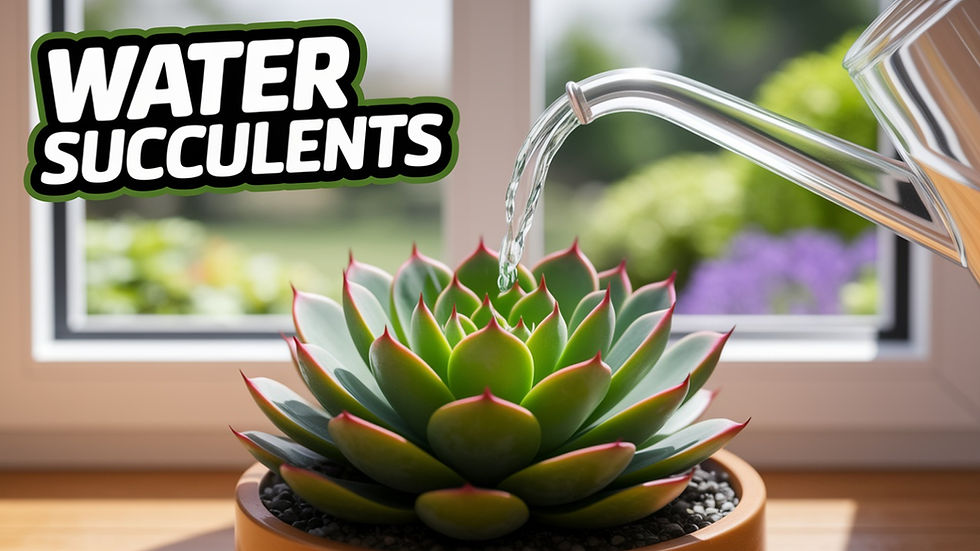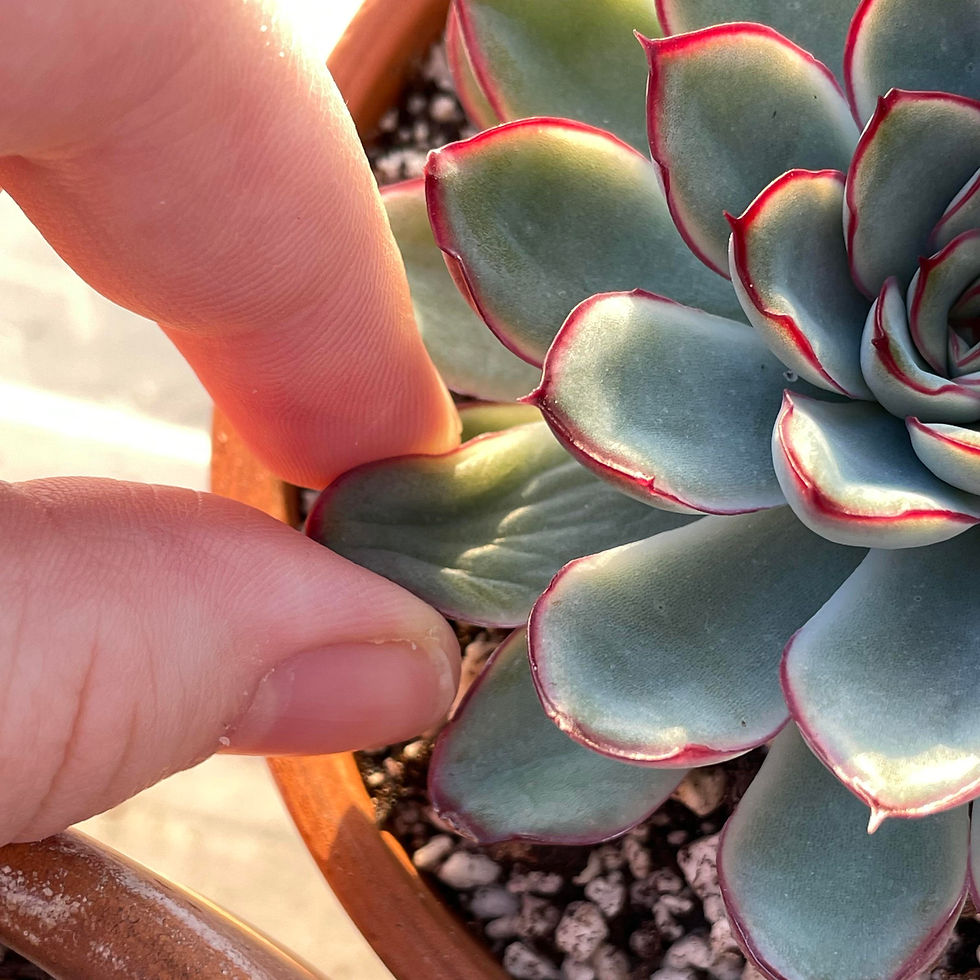How to Water Succulents
- Succulent Garden

- Apr 24
- 3 min read
Updated: Apr 26
Watering succulents correctly is crucial for their health, as they are adapted to store water and are prone to root rot if overwatered.

Here's a comprehensive guide on how to water your succulents:
THE ''SOAK AND DRY' METHOD
This is the most widely recommended and effective way to water succulents:
Water Thoroughly (Soak): When it's time to water, water deeply until water drains out of the drainage holes at the bottom of the pot. This ensures that the entire root system gets moistened.
Let the Soil Dry Out Completely: This is the most critical step. Allow the soil to dry out entirely between waterings. Don't water again until the soil feels completely dry to the touch, even a couple of inches below the surface.

Let the soil dry out completyly before watering succulents
HOW OFTEN TO WATER
There's no fixed schedule, as watering frequency depends on several factors:
Time of Year (Growing Season vs. Dormancy):
Spring and Summer (Active Growth): Succulents actively grow during these seasons and generally need more frequent watering. You might water every 1-3 weeks, depending on the conditions.
Fall and Winter (Dormancy): Growth slows down significantly during the cooler months. Succulents need much less water during this time. You might only need to water once a month or even less, depending on your climate and indoor conditions.
Type of Succulent: Some succulents need more water than others. Research the specific needs of your succulents if you're unsure. Smaller-leafed succulents may need more frequent watering than those with thick, fleshy leaves.
Pot Size and Material:
Smaller pots: Dry out faster than larger pots.
Terracotta pots: Are porous and allow for better airflow and faster drying, so plants in terracotta may need more frequent watering.
Plastic or glazed pots: Retain moisture longer.
Climate and Humidity:
Hot and dry conditions: Soil will dry out faster, requiring more frequent watering.
Cool and humid conditions: Soil will stay moist longer, requiring less frequent watering.
Light Exposure: Succulents in bright, sunny locations will generally need more water than those in lower light conditions.
Soil Type: A well-draining succulent or cactus mix will dry out faster than regular potting soil.
HOW TO TELL IF YOUR SUCCULENT NEEDS WATER

Instead of following a schedule, learn to recognize the signs of a thirsty succulent:
Wrinkled or Shriveled Leaves: This is a classic sign of dehydration as the plant uses its stored water. The leaves may also feel softer and less firm than usual.
Drooping or Limp Leaves: While overwatering can also cause drooping, underwatered leaves will often look deflated and lose their plumpness.
Soil is Bone Dry: Check the soil moisture with your finger or a moisture meter. If it's completely dry, it's likely time to water.
Aerial Roots: Some succulents may develop small, white roots growing from the stem above the soil line in search of moisture.
HOW TO WATER
Water at the Base: Aim the water directly at the soil, avoiding getting water on the leaves as much as possible. Wet leaves can lead to fungal issues. A watering can with a long, narrow spout or a squeeze bottle can be helpful.

Don't water on the leaves Consider Bottom Watering (Optional): Place the pot in a shallow dish of water and allow the soil to soak up moisture from the bottom through the drainage holes for about 30 minutes to an hour, or until the top of the soil feels moist. Then, remove the pot and let any excess water drain. This method can help ensure thorough saturation and reduce the risk of leaf rot.

Bottom watering Always Use Pots with Drainage Holes: This is non-negotiable for succulents. Excess water must be able to escape to prevent root rot. Empty any saucer beneath the pot after watering so the plant doesn't sit in standing water.

Pot with drainage holes
SIGN OF OVERWATERING (AND WHAT TO AVOID)
Overwatering is a much more common problem for succulents than underwatering and can be fatal. Watch out for these signs:
Mushy or Soft Leaves: Overwatered leaves become waterlogged and lose their firmness. They may feel squishy to the touch.
Yellow or Translucent Leaves: The leaves may start to turn yellow or become somewhat see-through.
Black Spots: These can indicate rot.
Dropping Leaves Easily: Overwatered leaves can become swollen and drop off with just a slight touch.
Soggy Soil: The soil will remain wet for extended periods.
Foul Odor from the Soil: This can be a sign of root rot.

Overwatered succulent
Key Takeaway:
The most important rule for watering succulents is to err on the side of underwatering rather than overwatering. They can tolerate dry conditions much better than being constantly wet. Pay attention to your plant's signals and the environmental conditions to determine the best watering schedule.







You mentioned watering in relationship to hot and dry or cool and humid climates, what about hot and humid climates such as NE Florida?
Can succulents survive outside in cold winter weather?